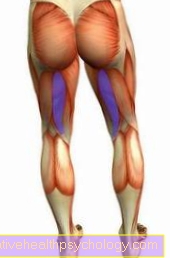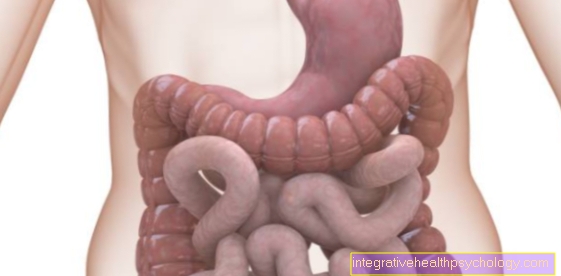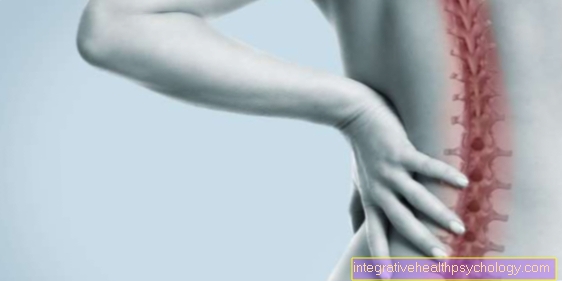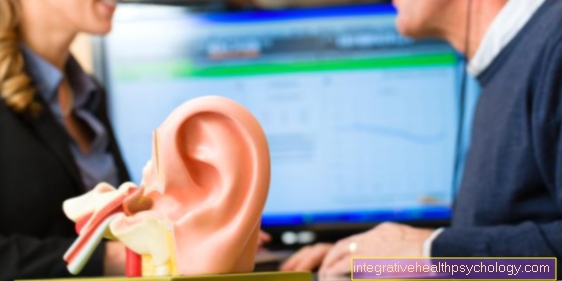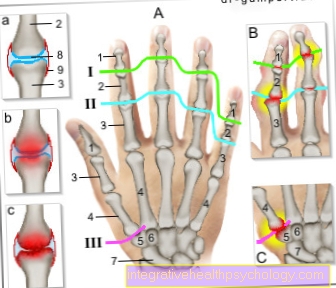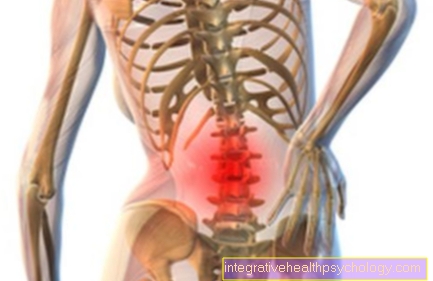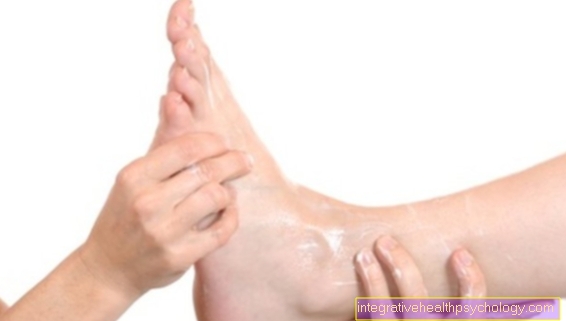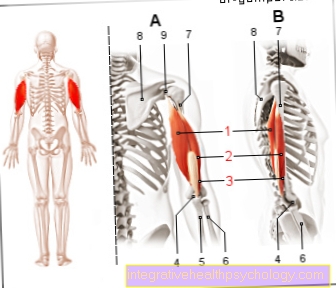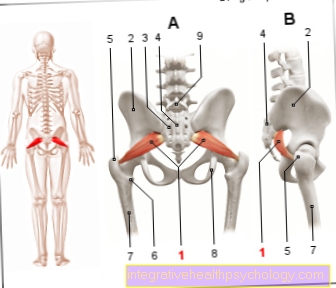Reflux esophagitis
definition
The term "reflux esophagitis" describes inflammation of the lower esophagus caused by contact between the esophageal mucosa and stomach acid. The causes, stages, courses and consequences of this disease can be numerous. Overall, these complaints are a very widespread problem, since up to 20% of the western population suffer from acid-related mucosal complaints of the stomach and esophagus.
The mucous membranes of the upper digestive tract are subject to a balanced relationship between the acid used for digestion and protective factors such as saliva, a layer of mucus and the slow movements of the muscles. If this relationship is disturbed by one of the numerous causes in favor of the acid, it can lead to recurrent heartburn, reflux oesophagitis and, in the long term, chronic reflux diseases and damage to the mucous membranes.

causes
The cause of reflux esophagitis is an excess of stomach acid on the mucous membranes of the esophagus. The acid attacks the mucous membranes, can initially cause heartburn, later also irritation, inflammation, ulcers and long-term changes and damage to the cell structures of the mucous membrane.
In most cases, the reason for the strong excess of acid is a combination of several factors. An important factor is the relaxation of the sphincter muscle at the transition from the esophagus to the stomach. This usually keeps the acid out of the esophagus, but for many people it can sag for some unknown reason. Diet and lifestyle habits also play an important role. They make reflux esophagitis a growing problem, particularly in the western world. High-fat foods, alcohol, nicotine, coffee, obesity, lack of exercise and stress are the main causes of reflux esophagitis.
Other underlying diseases of the gastrointestinal tract are less likely to be behind the disease. Operations on the stomach, pregnancy and constrictions in the digestive tract are other important factors in the development.
Read more about this under Causes of heartburn
diagnosis
The diagnosis begins with detailed inquiries about the symptoms and eating and living habits. Typical pain behind the breastbone after eating or when lying down already indicate heartburn. Initially, the diagnosis can be made with the help of a first attempt at therapy. For this purpose, so-called proton pump inhibitors are taken for a period of 7-14 days, which reduce acid production in the stomach. If the symptoms improve as a result, the diagnosis of acid-related irritation of the mucous membrane is made.
However, if the results of the therapeutic attempt are not clear, a more specific diagnosis can be made with the help of a gastroscopy. Here, irritations of the mucous membrane can be recognized and biopsies of the tissue can be taken. Furthermore, the pH of the esophagus should be measured with a probe for 24 hours. If this is below 4 at several points in time, this indicates reflux disease and an excess of acid.
The gastroscopy and pH measurement can and should also be carried out in the case of longstanding complaints, very unusual living and eating habits or at the request of the patient. In the case of very advanced symptoms and abnormalities in the gastroscopy, a biopsy can be taken so that the mucous membrane can be examined more closely under the microscope. Changes and slowly occurring tissue damage can be diagnosed here and a stage of the disease can be estimated.
Read more on the subject at: Gastroscopy
treatment
The treatment depends on the severity and duration of the symptoms, as well as the living conditions of the patient. First and foremost is a change in eating and lifestyle habits to cure or prevent initial symptoms such as heartburn or mild reflux oesophagitis. The change must include avoiding the risk factors, i.e. a low-fat diet and, if possible, abstaining from alcohol and nicotine. In addition, little time should be spent lying down during the day and you can sleep with a raised headboard at night to alleviate the symptoms. Additional exercise can continue to stimulate the muscles of the intestines and reduce reflux. Instead of consuming coffee, water or soothing teas should be drunk.
If the changes do not help to get the symptoms under control, a therapy attempt with proton pump inhibitors should be made. The most famous representatives are "Pantoprazole" and "Omeprazole". They stop the production of gastric acid in the mucous membrane cells of the stomach and thus also reduce the acid load on the esophagus. For mild reflux esophagitis, the medication is initially taken for 2 weeks. Irritation and slight inflammation can often heal during this time. Medicines from other groups of active substances, for example so-called "Antacids"Or"Prokinetics"Can reduce the amount of acid in the stomach.
However, surgical procedures may need to be used for advanced damage or severe inflammation. The most common operation of this disease is the "Fundoplication“, A procedure designed to narrow the entrance to the stomach and replace the sphincter at the bottom of the esophagus.
Read more about this under
- Proton pump inhibitors
- Effect of proton pump inhibitors
- Side effects of proton pump inhibitors
Diet for reflux esophagitis
Diet in reflux esophagitis plays an extremely important role in the development of the disease. Some foods not only influence the amount of acid in the stomach, but also the strength of the sphincter muscle at the stomach entrance and thus both essential criteria for the development of the disease.
The most dangerous foods in the development of reflux esophagitis are coffee, nicotine, and alcohol. Alcohol in particular also has a negative effect on the movement and strength of the muscles of the upper digestive tract. Furthermore, all foods that are particularly acidic or have a high energy content, such as fatty foods, should be considered. Sweet drinks and lemonades also pose an undreamt-of danger in the development of heartburn.
Light meals and foods such as potatoes, salads, low-fat fish and meat, still water and whole grain products are particularly gentle. These foods should also not be swallowed quickly in large portions.
Lush food before bed also poses a risk to the esophagus, as does inactivity after eating. Short exercise such as walks help to stimulate digestion and bridge the phase of high acid secretion in the stomach.
Read more on the subject at: Diet for heartburn
Concomitant symptoms
The main symptoms of reflux esophagitis are heartburn, pain behind the breastbone, as well as a feeling of pressure and pain when swallowing. The symptoms depend on the time of day and physical activity. This pain is often worsened when lying down, as the acid can more easily rise up the esophagus. The symptoms also become more severe after meals, as the gastric acid production for digestion increases reflexively. Belching and choking, as well as nausea and vomiting can also occur. As a result, the respiratory tract can become involved, which manifests itself in a chronic dry cough.
Duration
The duration of reflux esophagitis can vary widely. An important factor here is the frequency with which the symptoms appear and recur. The frequency allows a prognosis of the previous damage and the success of the therapy. Simple complaints such as initial heartburn can subside in a few hours. Often these occur only temporarily after eating fatty foods or at night.
If the esophagus is already inflamed, the symptoms are almost permanent. With the start of drug therapy, symptoms should subside within a few days. The therapy takes place in most cases for 2 weeks in order to give the mucous membrane the necessary time to heal completely. Recurring or therapy-resistant complaints can take on chronic courses. In these cases, the symptoms often persist for months to years.
Read more on the subject at: Duration of an esophagitis
Stages of reflux esophagitis
Grade 1 erosive reflux esophagitis
Many inflammations of the esophagus and acidic complaints of the stomach proceed without direct damage to the mucous membrane. In contrast, there is erosive reflux esophagitis, in which gastroscopy reveals an inflammation of the esophagus with the naked eye.
Erosive reflux esophagitis can be divided into four different degrees. Grade 1 is the lowest level of the disease, but the mucous membranes have already suffered microscopic or already visible damage. Small damage can be seen in the gastroscopy, but it is no larger than 5mm. At this stage, therapy by changing diet is useful, but is no longer sufficient on its own. Acid-inhibiting drugs often have to be used in order to enable complete healing.
Grade 2 erosive reflux esophagitis
The classification of erosive reflux esophagitis is followed by grade 2, which describes more severe damage to the mucous membranes. Several abrasions, so-called "Erosions“, Which are more than 5mm in size. However, most of the esophageal mucosa is still intact, in contrast to the remaining 2 degrees. Grade 2 requires urgent drug therapy and immediate change in eating habits. As the stages progress, extensive and very painful damage can occur, which are sometimes irreversible and pose a risk for further diseases of the stomach and esophagus.
Erosive-ulcer reflux esophagitis
The erosive-ulcerous form of reflux esophagitis represents a further stage of damage to the mucous membranes. In addition to the bulges and visible damage in the wall of the esophagus, ulcer-like changes are now also occurring. An ulcer describes an ulcer and damage that penetrates deep into all other wall layers of the organ below the mucous membrane.
The damage is already very advanced and is no longer limited to the mucous membrane. The symptoms worsen with an ulcer. The pain can sometimes be very sharp while you are eating. At this stage of reflux oesophagitis, immediate therapy must be given to prevent worse consequences, including esophageal cancer.
Chronic reflux esophagitis
Reflux esophagitis has a strong tendency to be chronic. This is due to the progressive relaxation of the sphincter muscle at the entrance to the stomach. This allows the acid to rise unchecked into the esophagus and irritate and inflame the sensitive mucous membrane there. Often, despite therapy, there is permanent irritation of the mucous membranes, so that even small amounts of acid are sufficient to trigger the inflammation again. Chronic reflux esophagitis is a huge and underestimated problem in the western world.
Even heartburn, which occurs twice or more a week, can cause severe damage to the esophagus for years. The mucous membrane cells located here can change and transform over years of irritation. As a result of these transformations, a so-called "Barrett's esophagus". This represents the pathological, complete acid-induced transformation of the lower esophagus and is an enormous risk factor for the development of esophageal cancer. People who already have erosive reflux oesophagitis have to undergo repeated gastroscopy at short intervals in order to identify and stop the progression of the disease and the development of the malignant cells at an early stage.





